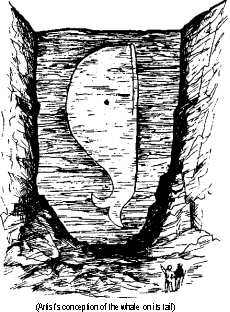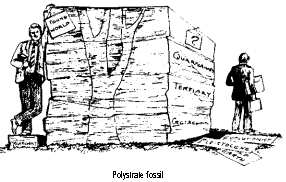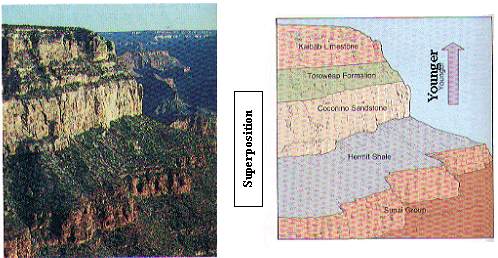
©1986 by Paul D. Ackerman http://www.creationism.org/books/ackerman/
 |
©1986 by Paul D. Ackerman http://www.creationism.org/books/ackerman/ |
|
9 - Back Down to Earth ... the earth is full of thy riches.
|
 |
Our own home, earth, is the place scientists
know the most about, and a great abundance of "clocks" have been found
all around us. One good example was the "fossil" meteorite clock explained
in chapter 2. A few clocks that we hear about all the time have been interpreted
in such a way that they seem to indicate long cosmic ages. The most common
are the various types of radioactive-decay clocks.
The Problems with Radioactive Clocks
As was seen in the previous chapter, however, the startling discovery that the speed of light has been slowing down through history changes the whole picture regarding radioactive clocks. It can now be seen that they do not indicate vast ages as formerly thought, since—as physicists well know— the speed at which a radioactive decay clock runs is directly related to the speed at which light travels.
Even before the uncovering of the light-speed
data, recent-creationists had uncovered much evidence to indicate that
there was something amiss with the standard evolutionist interpretation
of radioactive clocks. For example, the commonly cited uranium-lead decay
sequence gives off helium as a by-product. Yet not nearly "enough" helium
is present in the atmosphere, if this radioactive process has been occurring
for millions and billions of years, in the manner claimed by evolutionists.
In fact, there is only a few thousand years' worth of helium in the atmosphere,
even if all of it came from this source. For this reason recent-creationists
have often cited the amount of atmospheric helium as a clock indicating
a young earth.1
Also, large numbers of radioactive-dating
discrepancies and anomalies can be cited to indicate that unknown factors
and faulty assumptions may be at work. In 1968 scientists applied radiometric
dating to some rocks that were known to be less than 170 years old. They
knew this because the rocks had been formed by a volcanic eruption in 1800
on the island of Hualalai in Hawaii. The radioactive ages determined for
these 170-year-old rocks ranged from 160 million to 3 billion years.2
Obviously, something is wrong with this method. We will deal with this
subject further in chapter 11.
A Whale on Its Tail
More problematic than radiometric clocks to a young-earth position are certain geological features that seem to require long ages to form. By no means do creationist scientists have all the answers to these dilemmas, but more is being learned all the time.
One of the most intriguing examples of a dilemma for which new discoveries are leading to a solution involves a type of microscopic sea creature known as a diatom. Since this tiny creature has a shell that does not decompose when it dies, the shells of dead diatoms gradually settle down to the ocean bottoms and, under appropriate conditions, form deposits called diatomaceous earth. Such deposits can run to hundreds of feet of thickness and be remarkably free of other contaminates. The dilemma for the recent-creationist is how in the world such deposits can form in a relatively short period of time.

Although these features seem to present a considerable problem for the idea of a young earth, clear indications are in evidence that there must be a solution.
At a diatomaceous-earth quarry in Lompoc, California, a remarkable discovery was made during mining operations in 1976.3 Workers of the Dicalite Division of Grefco Corporation uncovered the fossil skeleton of a baleen whale. The whale fossil is standing on end in the quarry and is being exposed gradually as the diatomite is mined. Estimates are that the fossil is about eighty feet long.
What does this find mean? In a phrase, it means that this formation could not have been built up gradually over millions of years. The billions of tiny diatom shells making up the formation had to be deposited in a very short period of time. Here is why—
A creature that dies does not normally become a fossil. In order to do so it must be buried deeply and quickly in wet sediment to seal if off from the atmosphere, bacteria, and so forth. Otherwise it will simply rot. Thus, one can be confident that the eighty-foot portion of the formation containing the whale had to be deposited quickly.
In addition, if deposition of the diatoms was sporadic, with long periods of time separating brief periods of rapid deposition, there ought to be clear lines of erosional separation in the formation rather than a smooth and continuous conformity. Since there are no such erosional lines in the deposit, the indication is that not only the eighty-foot portion containing the fossil whale, but the remainder of the deposit as well, must have been deposited quickly. Other evidences point in the same direction for other kinds of deposits.
A Sword in a Stone
In the famous legend, Arthur shows that he is righteous and true by pulling Excalibur from a stone. A modern Excalibur of sorts is found under the imposing name polystrate fossils. The word means "many layers," and it refers to fossils—usually tree trunks—that cut through two or more layers of sedimentary rock. How do these sword-in-a-stone fossils indicate that the earth may not be as old as evolutionists believe?
To the average person, the most powerful witness to claims of vast prehistoric ages is the testimony of sometimes thousands of feet of sedimentary-rock layers and the fossils they contain. The sight of the Grand Canyon with its layer upon layer of sedimentary rock seems to imply the requirement of vast amounts of time. Evolutionists believe and propose that each layer represents an ancient world that long since perished. Recent-creationists, on the other hand, believe that these rock layers were all deposited quickly under catastrophic conditions in the relatively recent past. The occurrence of polystrate fossils in numerous places around the world is one dramatic piece of evidence that the recent-creationists may be right.
In order to see why, remember that fossil formation requires rapid burial and sealing from atmospheric and surface elements. Any organic material, such as wood, that is so exposed will not turn into a fossil. Rather, it will rot. Therefore, just as with the whale in the diatomite deposit, the entire length of a fossil tree trunk had to be buried quickly in order for it to fossilize.
However, in polystrate fossils, these tree trunks extend vertically and are incorporated into rock layers supposedly laid down in epochs separated by millions of years of time. The most obvious and straightforward interpretation of these fossils is that the sedimentary layers engulfing them were laid down in rapid succession during a single catastrophe in the past. They constitute a sort of frozen clock from the past, indicating that terrible things occurred—not over millions of years but very quickly. The earth's sedimentary-rock layers are not a testimony of life's long struggle upward but a witness of sudden terror and judgment.

Conclusion
Although the details of many deposits,
erosional features, formations, and so forth, present numerous mysteries
and dilemmas for the concept of recent creation as described in the Book
of Genesis, much exciting work is being done. New and amazing answers and
evidences are turning up all the time. Since the hard evidence we already
have indicates that there must be answers, creationists will continue to
look for them. As Walter Lang of the Bible-Science Association is fond
of saying, "If you just give science enough time it will finally catch
up with the Bible." I trust this book will help the reader to be more fully
assured of that fact.
Repealing Steno's Law of Superposition
Of the discoveries made since the original publication of Young World in 1986, none is more earth shaking than the overthrow of Niclaus Steno's Law of Superposition. Credit for the overthrow is due in large part to field research at Mount St Helens by American scientist, Steven Austin and laboratory experiments by French scientist, Guy Berthault. According to the Law of Superposition the layers of rock in the geologic column were laid down one on top of another. Therefore, a lower rock layer is older than those layers resting above it (see image).

Image from: http://shakti.trincoll.edu/~isample/Geological/OrigHoriz.html
The Natural Experiment at Mount St. Helens
A shuddering earthquake on Mount St Helens in May of 1980 released a volcanic eruption with an exploding force equivalent to 20 million tons of TNT. The eruption continued unabated for the next nine hours releasing the destructive energy of almost two Hiroshima-size atomic bombs each second. Scientists have supposed that such explosions produce a chaotic jumble of particles. The discoveries of Austin and Berthault demonstrate this is far from an accurate picture. During each second within an explosion (or flowing current) particles interact in lawful ways to produce sorting and layering effects such as found in the earth's sedimentary rocks. Individual rock layers are not laid down first one and then another, but, in fact, are deposited in groups at the same time and in conjunction with one another. For instance, Austin has documented that stratified (layered) deposits appearing to encompass thousands of years of geologic time were deposited in less than a day. Berthault, in laboratory experiments in the USA at the Engineering Research Center at Colorado State University, Fort Collins has demonstrated that layers of sediment form horizontally and vertically at the same time. In a flowing current, a series of layers forms together and progresses horizontally in the current's direction. When current speed changes, a new series of layers begins to form on top of the progressing lower layers. Since the layers form horizontally as well as vertically, a fossil buried in a lower layer might be the same age as one buried in a layer above it. 4
The eruption at Mount St. Helens involved the original blast and subsequent events over the next two years. This series of events created a depositional plain with an average depth of about 100 feet. Associated erosion events created canyons and cliff faces that allowed Austin to examine how the material had been deposited. Examination revealed that the particles in the eruption plain had been sorted and layered in a manner equivalent to that found in sedimentary rock formations all over the world. One might have supposed the layers to represent thousands of years rather than the work of a few catastrophic days within a period of about two years. Close inspection of the cliff faces revealed finely detailed layers or lamina. Scientists had thought that such fine layers indicated seasonal deposits and thus the result of many years of deposition. "It ain't necessarily so," is the clear testimony from Mt. Saint Helens. 5
The implications of these discoveries are staggering. The entire naturalist scenario of a vast pre-historical earth with supposed geologic ages is founded on the premise that the Law of Superposition is valid. We now know that it is not. In spite of its persistence and establishment and textbook orthodoxy, the scenario of vast geologic ages with its millions and billions of years is scientifically overthrown.
Technical Information Link: http://www.answersingenesis.org/docs/456.asp
]
PREV NEXT Start of: "It's A Young World After All" www.creationism.org